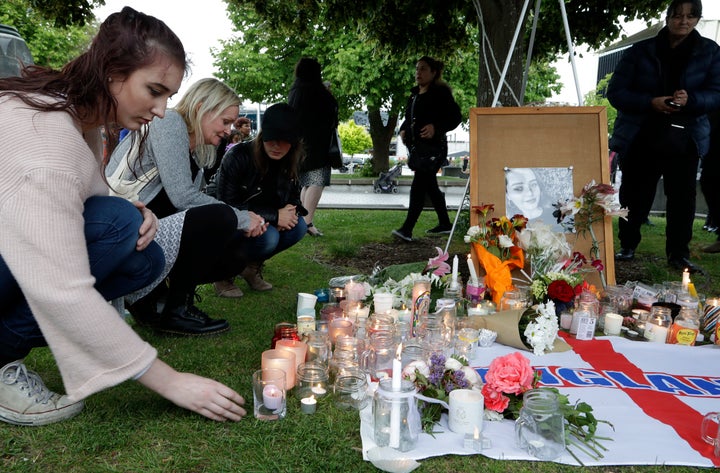British backpacker Grace Millane was just 21 when she was murdered, her body found in a suitcase buried somewhere in the scrub outside Auckland, New Zealand. The killer has now been found guilty. But a court order has allowed him to keep his anonymity, while details of Grace’s sexual preferences have been raked through the press.
And here are those details. First, Grace met a man through a dating app, second, they had a few drinks, thirdly, they had sex and she ended up dead. He began Googling things like “rigor mortis” and “large bags near me” before taking photos of her body, watching porn and going on another date. Later, he put Grace’s body into the bag.

As his defence, this man argued that Grace died by accident after their fetishistic sex went wrong. She had previously enjoyed exploring BDSM with her former boyfriend, her murdered claimed. She had also used a BDSM dating app. Here, she listed her preferred kinks. All these details were published as separate stories, as distinct claims in headlines that didn’t always make clear this was only one side of the story, and that we’ll never get hers.
It’s so clear where victim blaming like this comes from. When a young woman is killed, the knee-jerk reaction is to tell ourselves it could never happen to me. We use the details to reassure ourselves that no, we don’t do X, Y and Z, in precisely that order. It soon appears that to do X, Y and Z, in any order, becomes wrong, even if X, Y and Z end up being simply existing, in the world, as a woman. As long as death befalls women who do all or none of the wrong things, some will cling to any clue that they somehow willed it on themselves. But if us women victim blame out of some sick self-defence mechanism, what’s men’s purpose for doing the same? Are they unthinking enough to let sexist bias write their headlines, or do they genuinely want to police women’s behaviour?
BDSM and its subsections provide a whole alphabet of things that onlookers convince themselves set a distance between most women’s lives and Grace’s tragically short one. But finding fault in young women who toy with power dynamics helps no-one. Questioning male participants’ willingness to hurt women might lead the discussion somewhere more useful, though.
The murderer admitted he put his hand to Grace’s throat during sex, without her permission, simply “because girls usually enjoy it”. Some might, but how could anyone know without asking? I’d hazard porn – which he enjoys so much he watched it after literally killing a girl, and made some of her dead body – allowed him to think this. Here, violence against women is the norm. Research has found they are subject to physical aggression in 88% of the most popular scenes.
Authentic BDSM is not meant to be like this, its adherents insist. Indeed, BDSM, to its self-proclaimed swots, is built on trust and consent. This is sex LARPing (live action role-playing), where participants play fantastical characters, and use pre-approved safe words they know the others will respect, like actors do when a director shouts “cut” in a scene, or indeed LARPers do when another person dressed as a wizard yells “break”. What underpins this old school BDSM is a literacy that many others, especially those who’ve learned the literal ropes from porn, don’t have.
Regardless of whether Grace fully understood the boundaries of BDSM (listing her likes and dislikes on fetish sites and dating apps seems to suggest she did), her murderer should have known not to kill her. Because this wasn’t a sex game gone wrong, this was violence against women gone the way it normally does.
Kink is meant to be a subversion of the norm, but in a society where men are economically, socially and culturally lording it over women, what’s more normal, more painfully monotonous than wanting more of the same? Why are we questioning why a young, fresh-faced female graduate would opt to be into fetish when we should really be asking what motivates men to participate. How are these powerful adult men arriving at the conclusion that women are so regularly hurt by men, in a blood-letting of innocents that has become almost ritualistic in its precision and consistency, that they might as well give them a little more of the same when the night draws in?
Instead of treating BDSM as a complicated indie film that young women’s dinky little brains can’t wrap their heads around, we should acknowledge that women’s rights to exist safely, to have sex safely, to fantasise safely, are things that still, unfortunately, elude certain men. Not all men, but enough men for women in the UK alone to be 33 times more likely than a man to be killed by a partner or ex-partner. Enough for Grace to be the 59th British woman whose death was followed by a “sex game gone wrong” defence. Enough for rape convictions to be the lowest on record. And enough is enough. To save other women like Grace, we needn’t pore over women’s willingness to experiment, rather we should challenge men, nearly always older than their female partners, who think they’re the only ones who know the rules of pleasure. Because at the heart of it, women don’t crave their own destruction, they crave the pretence that it will never happen the way it so often does.
Sophie Wilkinson is a freelance journalist.

